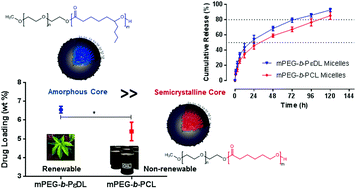Amphiphilic block copolymers from a renewable ε-decalactone monomer: prediction and characterization of micellar core effects on drug encapsulation and release†
Abstract
Here we describe a methoxy poly(ethyleneglycol)-b-poly(ε-decalactone) (mPEG-b-PεDL) copolymer and investigate the potential of the copolymer as a vehicle for solubilisation and sustained release of indomethacin (IND). The indomethacin loading and release from mPEG-b-PεDL micelles (amorphous cores) was compared against methoxy poly(ethyleneglycol)-b-poly(ε-caprolactone)(mPEG-b-PCL) micelles (semicrystalline cores). The drug–polymer compatibility was determined through a theoretical approach to predict drug incorporation into hydrated micelles. Polymer micelles were prepared by solvent evaporation and characterised for size, morphology, indomethacin loading and release. All the formulations generated spherical micelles but significantly larger mPEG-b-PεDL micelles were observed compared to mPEG-b-PCL micelles. A higher compatibility of the drug was predicted for PCL cores based on Flory–Huggins interaction parameters (χsp) using the Hansen solubility parameter (HSP) approach, but higher measured drug loadings were found in micelles with PεDL cores compared to PCL cores. This we attribute to the higher amorphous content in the PεDL-rich regions which generated higher micellar core volumes. Drug release studies showed that the semicrystalline PCL core was able to release IND over a longer period (80% drug release in 110 h) compared to PεDL core micelles (80% drug release in 72 h).



 Please wait while we load your content...
Please wait while we load your content...